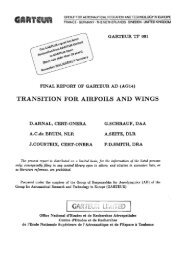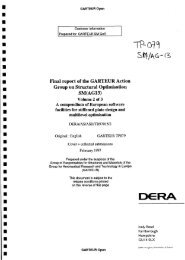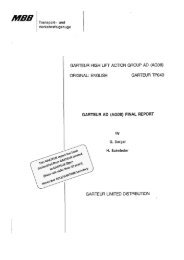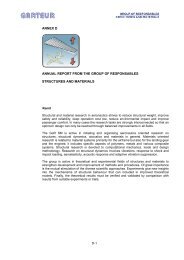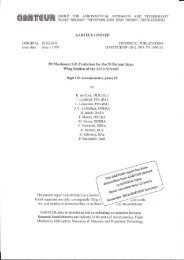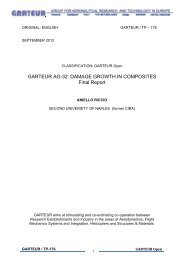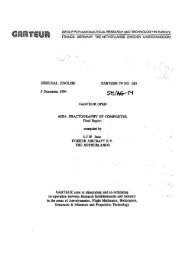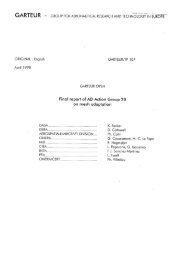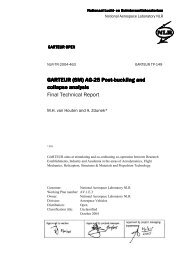Cadmium Substitution - garteur
Cadmium Substitution - garteur
Cadmium Substitution - garteur
You also want an ePaper? Increase the reach of your titles
YUMPU automatically turns print PDFs into web optimized ePapers that Google loves.
GARTEUR LIMITED<br />
3.4 Effect of coatings on fatigue performance<br />
Surface treatments such as pickling, anodising and plating may have a detrimental effect<br />
on the fatigue life of aerospace components. Constant amplitude fatigue tests have<br />
been made to determine the effects of the different coatings on the fatigue life of<br />
specimens machined from AISI 4340 steel tempered to give a tensile strength of 1400<br />
MPa. Both smooth specimens and notched specimens were used to give K t (stress<br />
concentration) values of 1.0, 1.4, 2.5 and 4.0. Tests were conducted at a frequency of<br />
185Hz and a stress ratio equal to 0.1. Details of the fatigue programme are given at<br />
Annex E.<br />
3.5 Stress corrosion cracking and hydrogen embrittlement studies<br />
High strength steels are susceptible to hydrogen embrittlement. Electroplating<br />
processes such as cadmium plating are less than 100% efficient and some hydrogen will<br />
be evolved during deposition, which may diffuse into the steel substrate. To reduce the<br />
risk of hydrogen embrittlement a post plating heat treatment is carried out on all steels<br />
with a strength greater than 1400 MPa. In the case of a steel part manufactured from a<br />
steel with a strength of 1850 MPa and electroplated with cadmium this would involve<br />
baking at 200 o C for a minimum of 18 hours. In the current programme, tests are being<br />
conducted on coated steel specimens to identify potential hydrogen embrittlement<br />
problems. After coating the samples are de-embrittled in accordance with the plating<br />
specification or the coating suppliers instructions.<br />
Two aspects of hydrogen embrittlement have been investigated. In the case of coatings<br />
prepared by electrodeposition, there is concern that the process itself may generate<br />
sufficient hydrogen to cause cracking under tensile loading. To investigate this sustained<br />
load testing and slow bend tests were carried out on coated samples. A second<br />
consideration is the possible introduction of hydrogen into the steel substrate as a result<br />
of corrosion occurring on the coating. This has been studied using notched tensile<br />
specimens. These are loaded to 75% of the notched tensile strength after coating and<br />
are then subjected to alternate immersion in 3.5% sodium chloride solution until failure<br />
occurs. The performance of each of the coatings is being compared with cadmium<br />
plating. Annex F describes the two test procedures employed and the results obtained.<br />
3.6 Resistance to aircraft chemicals<br />
Hydraulic fluids, aviation fuel, paint strippers and many of the other chemicals and liquids<br />
used on aircraft and in the maintenance of aircraft are potential corrosion hazards to the<br />
airframe structure. Immersion tests were carried out to establish the degree to which<br />
coatings degrade when exposed to some of the more commonly used aircraft chemicals.<br />
The range of chemicals includes<br />
• ethylene glycol<br />
• aviation fuel<br />
• butyl phosphate type hydraulic fluid<br />
• alkaline based general purpose cleaner<br />
Two test procedures have been employed both based on the immersion of coated<br />
panels in different aircraft fluids. The detailed test procedures are given in Annex G<br />
together with the test results.<br />
3.7 Paint adhesion<br />
GARTEUR SM/AG17 TP128 Page 5




